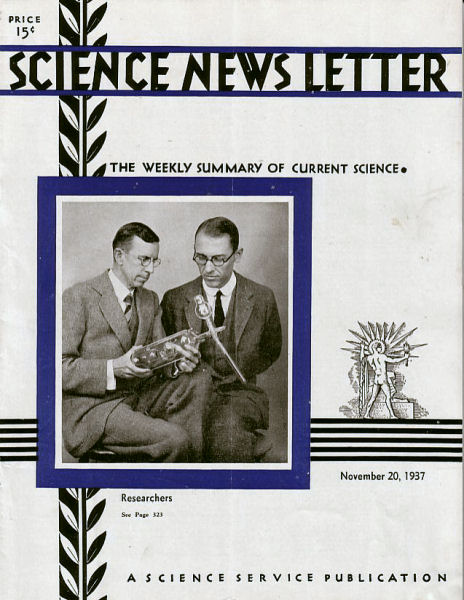From the November 20, 1937, issue

NOBEL PRIZES ARE AWARDED IN PHYSICS, CHEMISTRY, MEDICINE
A decade ago, two physicists, one an American, Dr. C.J. Davisson of Bell Telephone Laboratories, the other Prof. G.P. Thomson of Imperial College, London, discovered that electrons, the basic and smallest particles of matter, act like waves of light or X rays.
They showed that crystals scatter them. They confirmed experimentally the theory of wave mechanics that won for Prince Louis Victor de Broglie the Nobel laureate in physics in 1929.
This year’s Nobel Prize in Physics is shared by Davisson and Thomson, a world- acclaimed honor worth to each of them about $20,000 in cash and much more in prestige.
Today this diffraction of electrons is being put to practical use. As a tool of science it compares, in its field, with X-ray analysis. X-ray diffractions by crystals are powerful tools to probe the depths of metals and other crystals. The special merit of electron diffraction is the analysis of the surface of crystals and the structure of very thin films of materials. X rays are useless for such surface and thin-film studies. They are so piercing that they go right through the sample without disclosing sought-for information. Electrons—far less piercing—are stopped, scattered, and reflected by crystal surfaces and thin films and thus are vitally useful for this type of research.
Only a few weeks ago it was suggested that the methods of electron diffraction might well be used as a potent tool for biological research in studying the very thin films that separate cells of the animal and human body.
Quite independently, the two new Nobelists made the same discovery in 1927. Dr. Davisson, who worked jointly with Dr. L.H. Germer, found high-speed electrons were scattered by a crystal of nickel. Prof. Thomson, then at the University of Aberdeen, shot low-speed electrons through a screen composed of a film of pure gold leaf. Drs. Davisson and Germer published first. Drs. Davisson and Germer are shown on the front cover of this week’s Science News Letter.
PETROLEUM CHEMISTS TOLD OF NEED FOR BASIC RESEARCH
Research in the chemistry of petroleum and its products has had to be rather higgledy-piggledy for a quarter of a century because the automobile industry has been a chronic Oliver Twist, holding out its dish and hungrily crying for “more.” Research energies have had to be concentrated on meeting this terrific demand.
But now it is time to get down to real fundamentals of petroleum chemistry research, Dr. Harrison E. Howe, editor of Industrial and Engineering Chemistry, told the American Petroleum Institute. Thus far, petroleum chemists have been so busy as “oil cooks” that they have had time to find out the fundamental nature of only about 10 percent of the complex mixture that is crude oil. They need to work out the other ninety percent of this basic knowledge, and then find out more about what the whole thing is good for.
“The petroleum industry owes its growth to research and the application of its results,” Dr. Howe declared. “It must continue a research program, with adequate staffs of carefully trained and chosen men giving their attention to expertly chosen problems, if it would maintain its position.”
CAN NOW SEND PICTURES BY DOTS AND DASHES
A German inventor has been granted a U.S. patent on a system of transmitting photos over wires by dots and dashes.
Unlike the standard method of transmitting photos, the new system breaks a picture up into dots of various shades of gray and black, and converts the various shades into electrical impulses which are turned into dots and dashes for ordinary telegraphic transmission.
Siemens and Halske, the internationally famous German engineering corporation, has been assigned the patent by Johannes Hermann of Berlin Siemensstadt, its inventor.
Telegraphic photo systems in use today send the electrical impulses into which a picture is broken up directly over the wires instead of converting them into dots and dashes first, as does the new method.







